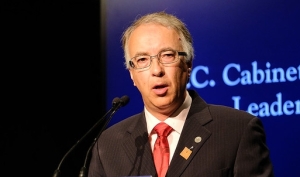Clean Energy Canada | Our response to the B.C. Conservatives’ energy plan
October 1, 2024

VICTORIA — Mark Zacharias, executive director at Clean Energy Canada, made the following statement in response to the Conservative Party of British Columbia’s “Powering BC” energy plan. Clean Energy Canada will be responding to each party’s energy plan in advance of the B.C. election.
“The Conservative Party of British Columbia’s energy plan released today asserts that it is a ‘bold plan for affordable, reliable, and independent energy.’
“The plan correctly recognizes that we will need new energy infrastructure to meet future demand and to build it quickly. It also correctly acknowledges that meeting future electricity demand will require a suite of technologies—that could potentially include nuclear in the longer-term—working together in a way that keeps rates affordable while building out a grid that maintains reliability.
“Other parts of the Conservative plan, however, are centred on several false assumptions. The first is that ‘energy independence’ will make life more affordable for British Columbians. While ‘energy independence’ is undefined in the plan, we assume it to mean that the province’s energy grid must be able to produce 100% of the province’s energy needs on the coldest (or hottest) days. What this means in practice is that B.C.’s energy system must be built for peak load, meaning a large part of the energy system will sit idle at great cost only to be used every couple of years.
“This is an expensive solution to a non-problem. Currently, B.C. both buys and sells electricity to our neighbouring provinces and states. For the entire 2019 to 2023 period, B.C. was a net exporter of electricity. In any given year, the balance between the amount of power available and the amount of power needed can result in a surplus or deficit of power for BC Hydro. Over the last 15 years, B.C. was a net importer in seven of those years and a net exporter in the other eight. In fact, importing cheap power allows BC Hydro to maintain reservoir levels to generate enough power during cold snaps and heat waves.
“The second false assumption is that EV sales requirements and other government programs to transition homes and buildings to electric heat pumps will ‘push our grid to the breaking point,’ adding sufficient load to our electricity grid such that its reliability is compromised. BC Hydro estimates that the current EV sales requirements in place will increase final electricity demand by 2% in 2030. This increase in electricity demand aligns with global forecasts by the International Energy Agency showing that EVs accounted for about 0.5% of the world’s total final electricity consumption in 2023, and around 1% in China and Europe. By 2030, EVs are projected to consume about 4% of global final electricity demand.
“Electric heat pumps use significantly less electricity than baseboard heating, and thus switching to them lowers grid demand and saves money for the 40% of B.C. households heating their homes with electric baseboards. A heat pump is also three to five times more efficient than a natural gas furnace. Certain commentators have greatly overstated the amount of electricity generation B.C. will require as it electrifies buildings, having failed to account for the efficiency rate of heat pumps and the complementary decline in electricity demand resulting from people switching from baseboard heating. What’s more, as Clean Energy Canada will show in a forthcoming report, a typical household transitioning from a natural gas furnace to a heat pump is also expected to save some $550 per year in B.C.
“It is also worth noting that a certain phrase used in the plan—the ‘forced electrification of vehicles and heating systems’—is an inaccurate way to describe current government measures. Rather, there is a proposal to regulate high-efficiency heating equipment, which would include dual-fuel systems, and the zero carbon step code for new builds, which regulates emissions and could incentivize the use of renewable natural gas in appliances, for example. B.C.’s EV requirements, meanwhile, allow for plug-in hybrids.
“And finally, the Conservative plan suggests that renewable energy sources, such as wind and solar, only make economic sense in certain situations. The reality is that wind and solar globally are the cheapest sources of power. An analysis from Clean Energy Canada found that solar and wind with battery storage are set to produce cheaper electricity than natural gas in Alberta and Ontario, and this trend is expected to be similar for B.C.
“While wind and solar are variable resources, solutions are available to complement them, from stronger grids and interconnections to demand-side measures (such as the smart charging of EVs and industrial demand response), affordable storage, and dispatchable power supply. These options can enable relatively high shares of wind and solar on a grid. Indeed, a look at other countries around the world offers plenty of examples of high wind and solar shares, such as 67% in Denmark, around 40% in Germany and the Netherlands, and 28% in Australia.
“In contrast, small modular nuclear reactors—while providing beneficial baseload power—are not yet commercially available and may or may not be cost-competitive for B.C.’s grid in the future.
“Clean Energy Canada will also be responding to energy plans from the British Columbia New Democratic Party and the Green Party of British Columbia ahead of the B.C. election.”